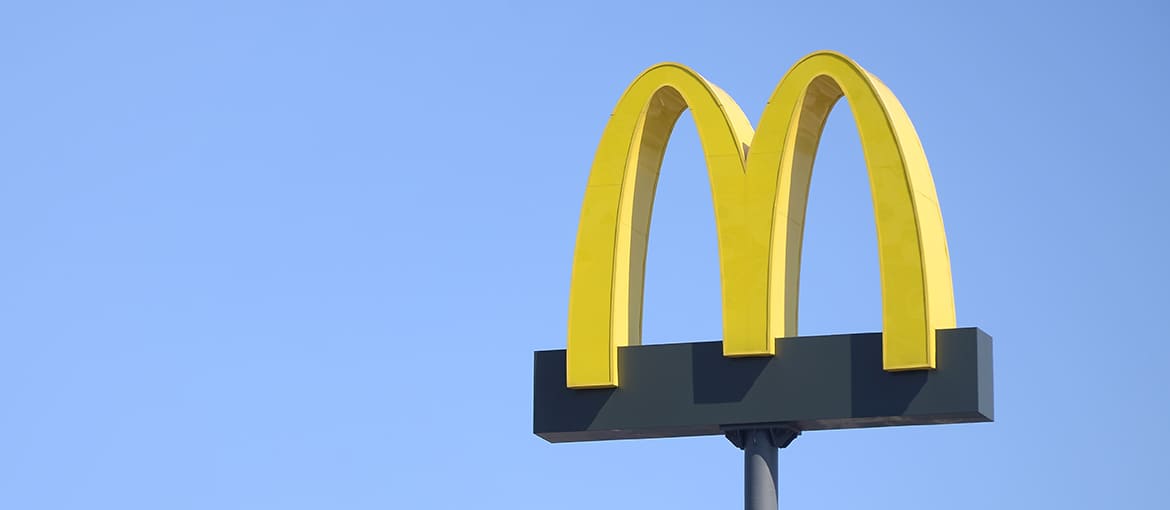Table of Contents
In the interest of balance, given that we’ve already covered the story of the Burger King logo, today we’re focusing on that of its arch-enemy: McDonald’s. Its logo is one of the most famous on Earth, but few know how it was born or what it looked like before the company adopted the iconic “M”. Yes, that’s right: there was a time when the McDonald’s logo was something else entirely…
An epic story
Anyone who’s seen the film The Founder will already by familiar with this story.
It begins with Dick and Mac McDonald, two brothers who moved to California to seek their fortune. In 1940, they opened their first barbecue restaurant close to a service station in San Bernardino. So far, so ordinary, if it weren’t for their Speedee Service System: an innovative production system that allowed them to prepare hamburgers at lightning speed and sell them incredibly cheap: 15 cents!
It was ushered in the era of fast-food, self-service and affordably priced food.
Enter he third character in this story: Ray Kroc, a milkshake mixer salesman. In 1954, Ray Kroc received an order for eight mixers from the McDonald brothers. Curious, he decided to jump in his car and go and see this barbecue joint that had placed this unusually large order. He came away impressed by the Speedee Service System in which he saw enormous potential for profit. Long story short, Ray Kroc became the franchising agent for the restaurant and the McDonald’s brand rapidly expanded, first in America, and then to the rest of the world. Today, the company has over 36,000 restaurants across the globe.
And the logo? How has it changed over time? What did the original look like? We chart its evolution down the years.
McDonald’s logos past and present
It’s 1940 and McDonald’s is still a run-of-the-mill barbecue restaurant. And this can be seen in its logo: a rectangle with three lines of black text on a white background. Very conventional, and a very long way from today’s identity.

In 1948, it was redesigned: “barbecue” was replaced by “hamburgers”, the brothers having decided to focus on a product that was becoming increasingly popular. “Buy em by the bag” was also added to highlight the option to take away. In bold (and repeated twice) is the super competitive price. It’s a logo rich in detail that highlights all the strengths of the restaurant: the originality of its offering and how it can be consumed, as well as its affordability.

In 1953 something changed. Or rather everything changed. Along came a mascot called Speedee, a friendly chef with a hamburger-shaped face. Above him was the word “McDonald’s” in red lettering. This logo, although still a long way from today’s, is interesting because it introduces elements that would stand the test of time:
- The colour red, which catches the eye and whets the appetite;
- The sense of joy that it conveys.

It’s now 1961 and we’ve reached a pivotal moment for McDonald’s: the first appearance of the famous “Golden Arches”. For an outlet in Downey, California, the McDonalds brothers create two giant golden arches at edges of the building to make it more visible from afar. The 1961 logo, designed by creative director Jim Schindler, was inspired by this architectural feature. Furthermore, yellow was introduced, a colour that brings cheeriness and remains a key part of the visual identity today.

In 1968, the logo was again redesigned and simplified, with the arches coming together to form the letter “M”. It was the precursor to today’s logo.

Ever since, the main elements of the logo have remained unchanged, although tweaks have continued to be made: the position of the text and thickness of the “M” has changed, the background colour has switched from white to red and back again… until finally changing to dark green in 2007 to highlight the chain’s efforts towards environmental sustainability.
We now jump forward in time to 2020. You’ve probably seen the (brilliant) temporary tweak to the logo made during the Covid-19 pandemic to encourage social distancing.

Well done McDonald’s!

